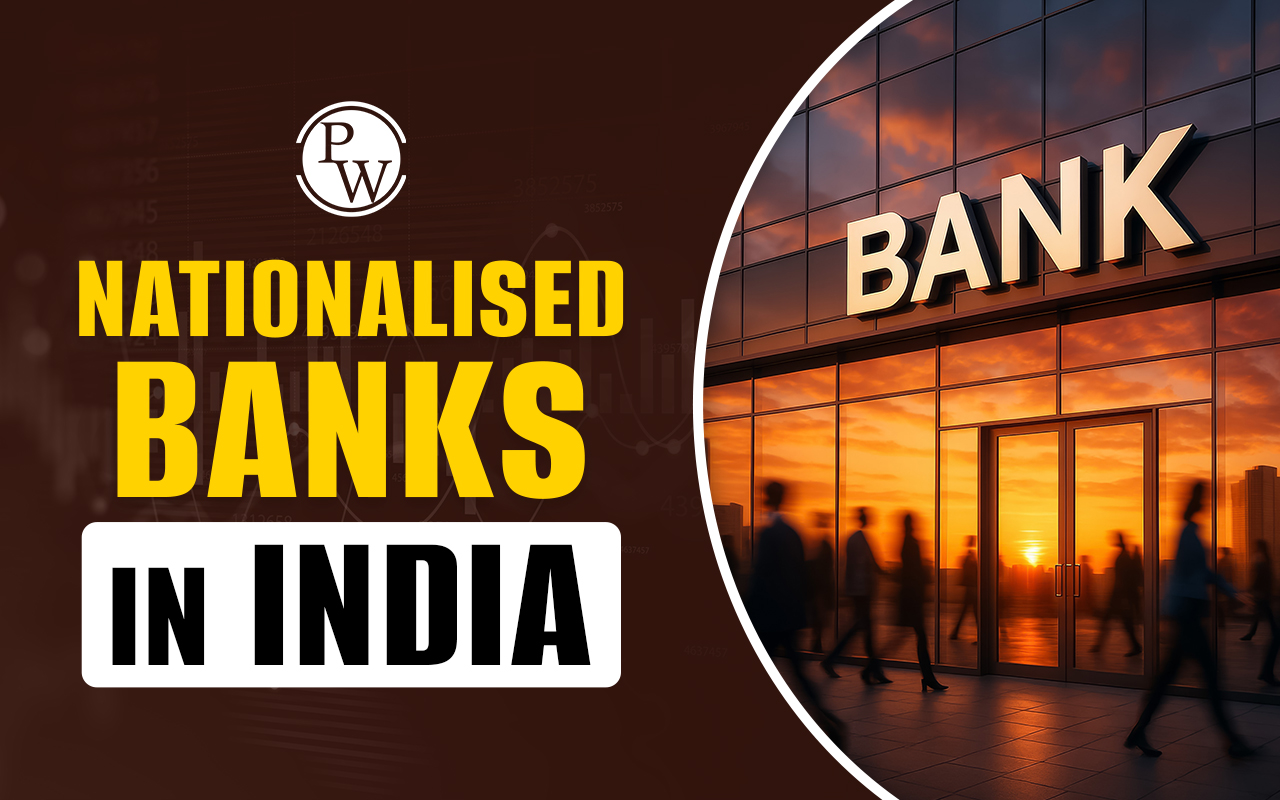
Nationalised Banks in India are government-owned banks where the majority stake (over 50%) is held by the Government of India. These banks were nationalised mainly in 1969 and 1980 to improve access to banking services across rural and underserved areas. Their main goal is not just profit, but also public service. Nationalised banks help implement key government schemes such as Jan Dhan Yojana, PM Kisan, and Mudra Loans. They are known for their wide branch network, especially in rural and semi-urban regions, and for offering stable and secure banking services.
Over the years, several banks have been merged to improve efficiency and reduce costs, but nationalised banks still remain central to India’s financial system. Check complete details about Nationalised Bank, List of Nationalised Banks in India, Advantages, and more below.
What is Nationalised Bank?
A Nationalised Bank in India is a commercial bank that was originally privately owned but later brought under government ownership through an official act of nationalisation. This was done to ensure banking services reach rural and underserved areas, and to shift the focus from profit-making to public welfare and inclusive growth.
The first nationalisation occurred in 1955, when the Imperial Bank of India was nationalised to form the State Bank of India (SBI). Later, in 1969, the Government of India nationalised 14 major private banks, followed by 6 more banks in 1980, bringing the total to 20 nationalised banks, apart from SBI.
These banks, now part of the Public Sector Banks (PSBs), are regulated by the Reserve Bank of India (RBI). They play a key role in implementing government initiatives like Jan Dhan Yojana, Mudra Loans, and PM Kisan, supporting sectors such as agriculture, small businesses, and financial inclusion.
Features of Nationalised Banks in India
Nationalised banks in India have core features that distinguish them, mainly due to their government ownership and social objectives. These banks aim not just for profit, but for financial inclusion and national development, particularly serving rural and underprivileged sectors.
-
Majority government ownership ensures public trust and credibility.
-
Focus on social welfare over maximum profit, expanding access to the whole population.
-
Wide branch networks, especially in rural and semi-urban regions.
-
Support for government schemes like Jan Dhan Yojana, Mudra Loans, and direct benefit transfers.
-
Priority sector lending to agriculture, MSMEs, and weaker sections.
The nationalised bank meaning specifically refers to a private commercial bank that was taken over by the Government of India through a legislative act, converting it into a Public Sector Undertaking (PSU).
Services Provided by Nationalised Banks
Nationalised banks provide a diverse range of services to fulfill banking needs for every section of society. Their service portfolio aims at both basic and advanced needs of customers.
-
Savings and current account opening with secure deposit facilities.
-
Loans for housing, education, agriculture, businesses, and vehicles at government-directed rates.
-
Implementation of government schemes, pension, and DBT payments.
-
Safe deposit lockers, remittance, mobile and internet banking.
-
Financial education and inclusion programs, especially in rural areas.
List of Nationalised Banks in India (2025)
Nationalised Banks, also called Public Sector Banks (PSBs), are commercial banks where the Government of India owns more than 51% of the stake. These banks were nationalised to improve access to banking services across the country, especially in rural and semi-urban areas, and to support key sectors like agriculture, MSMEs, and public welfare.
After a series of mergers and consolidations, India now has 12 nationalised banks, all regulated by the Reserve Bank of India (RBI).
1. State Bank of India (SBI)
India’s largest public sector bank, SBI originated from the Imperial Bank of India, which was nationalised in 1955. With a history dating back to 1806, SBI offers extensive retail, corporate, digital, and international banking services, with thousands of branches and ATMs across the country.
2. Punjab National Bank (PNB)
Founded in 1894, PNB is one of the oldest Indian banks. It merged with Oriental Bank of Commerce and United Bank of India in 2020, becoming the second-largest PSB. Headquartered in New Delhi, it offers a wide range of retail, corporate, and global banking services.
3. Bank of Baroda (BoB)
Established in 1908, BoB became the third-largest bank after merging with Dena Bank and Vijaya Bank in 2019. Known for its international presence, it serves over 20 countries and is recognized for strong digital banking and NRI services.
4. Canara Bank
In 1906, Canara Bank was founded in Mangalore, and it merged with Syndicate Bank in 2020. It is one of the leading banks in southern India and is recognised for its digital innovation, agri finance, and MSME services.
5. Union Bank of India
Founded in 1919, its inauguration ceremony was graced by the presence of Mahatma Gandhi. Following the 2020 mergers with Andhra Bank and Corporation Bank, it has become a leading pan-India bank combating financial exclusion and leading digital change.
6. Indian Bank
Founded in 1907 as part of the Swadeshi Movement, Indian Bank was acquired by Allahabad Bank in 2020 that drastically expanded its reach, especially in rural areas. It is based in Chennai and it is also actively engaged in financial literacy and government programs.
7. Bank of India (BOI)
The Bank of India is one of the legacy banks in India, established in 1906. It marks several milestones like being the first Indian bank to open an international branch in London (1946) and being a founding member of SWIFT. The bank is also well-known for international banking, trade finance, and SME support.
8. Bank of Maharashtra
It was launched in 1935 and it is primarily operational in Maharashtra and central India. The bank is dedicated to customised banking services, MSME lending and rural development, and is based in Pune.
9. Central Bank of India
The Central bank of India was started in 1911 and is regarded as the first Indian commercial bank with an Indian management. It is reputed to encourage financial inclusion, the addition of zero-balance savings accounts, and the low-income population.
10. Indian Overseas Bank (IOB)
Formed in 1937, IOB was created to support foreign exchange and international trade. Headquartered in Chennai, it has a strong presence in South India and Southeast Asia, serving both retail and business customers.
11. UCO Bank
UCO Bank was nationalised in 1969 after it was founded in 1943 in Kolkata by G.D. Birla. It has an extensive network in India and operations in Singapore and Hong Kong. The bank promotes priority sector lending and inclusion in finance.
12. Punjab & Sind Bank
This bank was founded in the year 1908 and was nationalised in 1980. It is based in New Delhi and it mainly serves Northern India and is involved in lending to SMEs and offering cheap banking services.
Top 5 Nationalised Banks in India
| Rank | Bank Name | Headquarters | Key Insight |
| 1 | State Bank of India (SBI) | Mumbai, Maharashtra | India's largest bank by assets, deposits, branches, and market capitalization. |
| 2 | Punjab National Bank (PNB) | New Delhi, Delhi | Second-largest PSB after its merger with Oriental Bank of Commerce & United Bank of India. |
| 3 | Bank of Baroda (BOB) | Vadodara, Gujarat | A leading international Public Sector Bank with a global footprint across many countries. |
| 4 | Canara Bank | Bengaluru, Karnataka | One of the largest consolidated banks, with a strong focus on digital banking and MSME financing. |
| 5 | Union Bank of India (UBI) | Mumbai, Maharashtra | A major PSB following its merger with Andhra Bank and Corporation Bank. |
Advantages of Nationalised Banks in India
The key benefits of Nationalised Banks in India are as follows:
- Financial Inclusion: Nationalised banks have increased activities in rural and semi-urban regions. This has served to avail the basic banking services to the previously unbanked people including savings account, credit, and insurance.
- Priority Sector Lending: These banks specialize in providing loans to industries that are significant to the national development like agriculture, small business (MSMEs), education, and housing.
- Democratization of Credit: Nationalisation minimised monopoly of financial resources in the hands of a small number of industrial families. It guaranteed greater and equal availability of credit to the various groups in society.
- Implementation of Government Schemes: Nationalised banks are important in the delivery of a number of welfare schemes provided by the government including Mudra Loans, Direct Benefit Transfer (DBT), and pension schemes.
- Economic Stability: State ownership is associated with credibility and dependability. Such banks contribute to the preservation of stability during economic crises because they will still offer the necessary services and save the money of depositors.
- Employment Generation: India has some of the largest employers in the public sector banks. They provide secure employment including benefits and career development.
- Focus on Social Responsibility: Nationalised banks are not operated by profit maximisation as is the case with the private banks but rather by the aspirations of national development. They give importance to lending and services that assist in economic equality and poverty reduction.
Nationalised Banks vs Private Banks in India
It is important to understand how nationalised (public sector) banks differ from private sector banks in India. The nationalised banks vs private banks table below highlights some of the key differences to help compare both segments:
|
Nationalised Banks vs Private Banks in India |
||
|---|---|---|
|
Criteria |
Nationalised Banks (Public) |
Private Banks |
|
Ownership |
Majority government owned |
Owned by private entities |
|
Primary Objective |
Social welfare, financial inclusion |
Maximising profit and growth |
|
Network Reach |
Extensive, rural and urban |
Strong presence in cities |
|
Customer Service |
Standardized, less aggressive |
More technology-driven |
|
Interest Rates |
Often slightly lower |
May offer higher rates |
|
Support Govt. Schemes |
Yes; implement many schemes |
Limited |
|
Risk Profile |
Backed by govt, lower perceived risk |
May have higher risk |
Nationalised Banks in India FAQs
How many nationalised banks are there in India?
Is Federal Bank a nationalised bank?
Which is the 12th nationalised bank in India?
Which are the top 5 nationalised banks in India?
The top nationalised banks based on size, network and reach are:
-
SBI
-
Punjab National Bank
-
Bank of Baroda
-
Canara Bank
-
Union Bank of India










